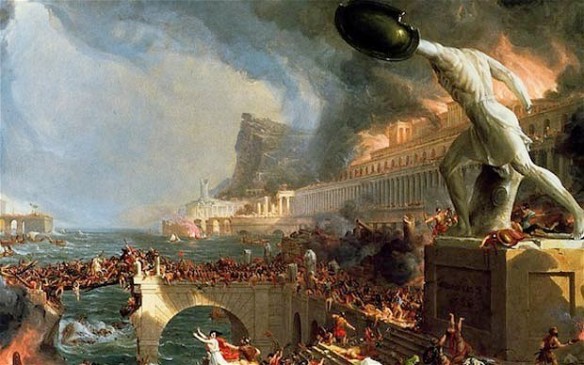Europe in 477 CE. Highlighted areas are Roman lands that survived the deposition of Romulus Augustulus
Rome clearly evolved over time; however, many of these changes were not healthful to the empire. Indeed, some changes led to its decline and fall, although historians differ as to which ones proved fatal. Comparing and contrasting the various hypotheses or why such a powerful empire collapsed upon itself is instructive.
Some historians suggest that Rome’s collapse came about with a decline in the quality and quantity of its soldiers. On the surface this may make sense, since successful invasions during the fifth century indicate the attackers overwhelmed and outmatched Rome. However, the Western armies did not suffer the sorts of crushing defeats that plagued the Eastern armies. Therefore, the army was not uniformly weak, and was, in fact, quite successful on some fronts. For example, Valens’ disaster at Adrianople was an Eastern, not a Western, defeat. Had Valens waited for his nephew’s army, he probably would have won the engagement. Indeed, Valentinian in the West had restored and strengthened the military’s defenses. The Visigoth invasion was not caused by the insecurity of the Rhine region, but rather by the political maneuvering of Theodosius the Great; and, the Huns’ successful invasion was aided, in part, by incompetent Eastern military policy. As for the army being outmatched, Aetius clearly showed Western Roman superiority in both Italy and Gaul. If there was any military inferiority, in size or competence, it falls to the East, especially in such disastrous decisions as sending the fleet against Gaiseric in 441.
The second argument for a military collapse was the West’s geographical position. While the Caucasus and Black Sea, and Constantinople’s strategic location sheltered the East from barbarian invasions, the West had no such natural defenses. Thus, the argument that the West fell because of its geographical vulnerability to invasion seems attractive and sensible. But Rome’s Eastern neighbor, Persia, constituted a more serious threat to Roman boundaries than did any force in the North, and Rome expended much energy and manpower in the East. Nevertheless, the West had the long boundary drawn upon the Rhine and Danube Rivers which provided a weak natural barrier. Unlike Constantinople and its narrow land mass, there existed no secondary line of defense for Gaul, and only a weak one for Italy, the Alps. While it is true that the Germanic tribes ultimately extinguished the Roman rulers, they did not do so with the sword, and the Fall of Rome cannot be fully explained as being the result of military incompetence.
A second hypothesis, closely associated with the military, is that the West lacked competent political leaders, although the East did not. Indeed, one might argue, all the Western emperors after Theodosius were utter failures, and the incompetent rule of Honorius probably accelerated the West’s fall more than any other factor. This hypothesis is convenient until critically examined. For instance, until the reign of Justin, all of the Eastern emperors were as dismal as their Western counterparts. Not as inept as Honorius, Theodosius II still did not inspire great confidence. More importantly, incompetent leaders were not unique to this period. Caligula, Nero, Commodus, Elagabalus, numerous third-century leaders, Constantius II, and even Julian failed miserably, and the empire endured, despite their blunders. The factor that marks this period is that a confluence of poor leaders and non-Roman advisors rendered the political climate dangerous in ways it had not previously been. Had these later advisors been “traditional” Romans, the state might have persevered, but many of these “traditional” Romans were worse than the Germans, and always had been.
